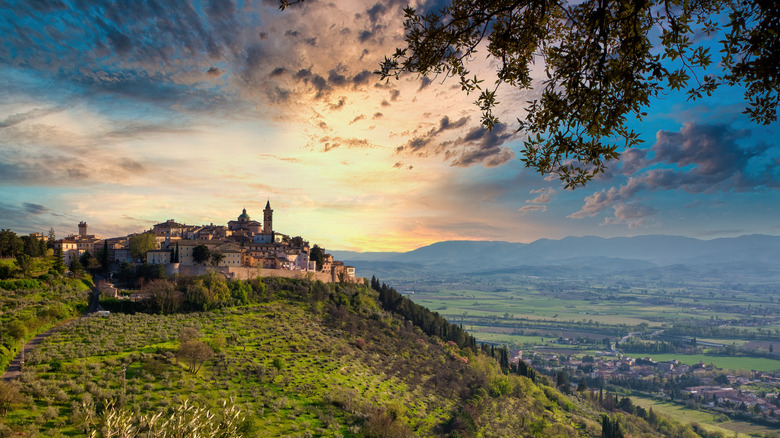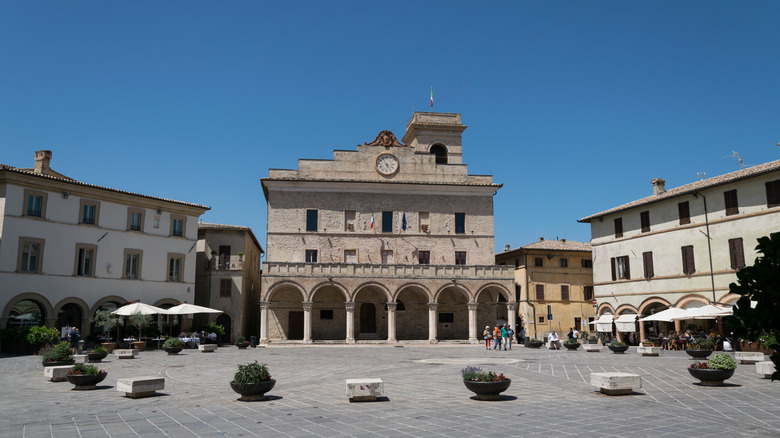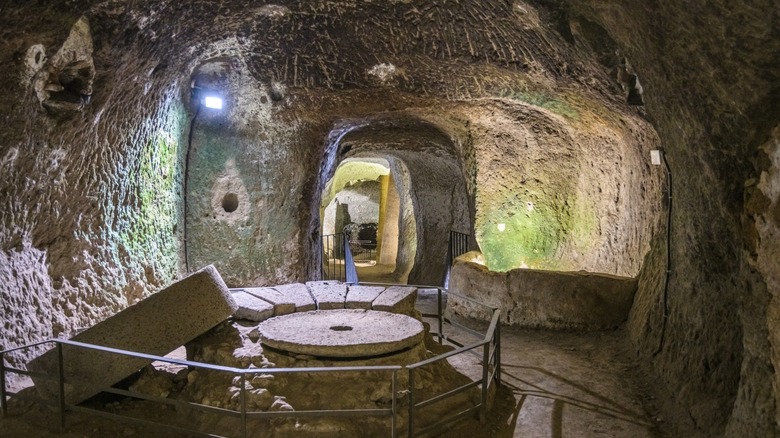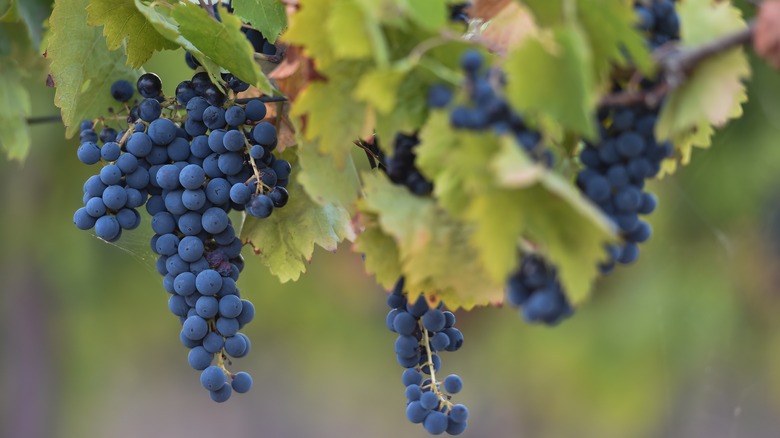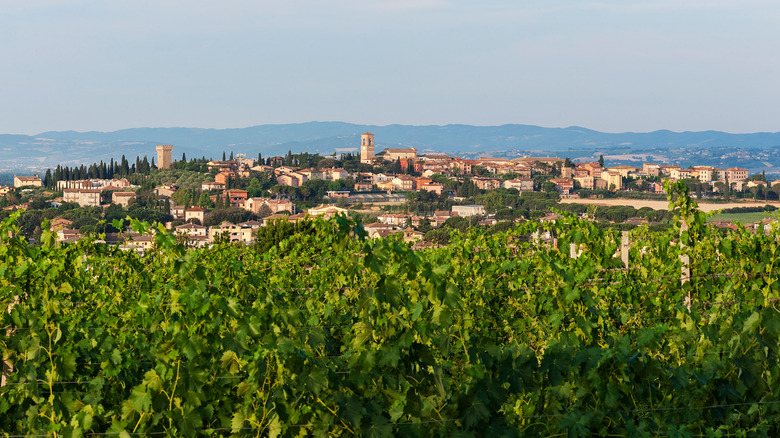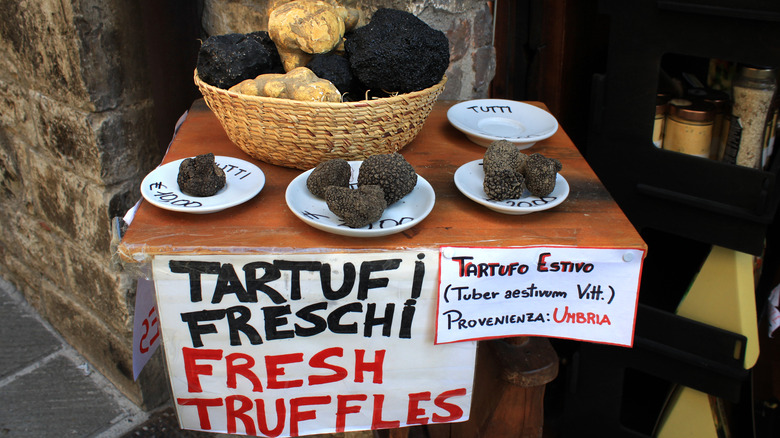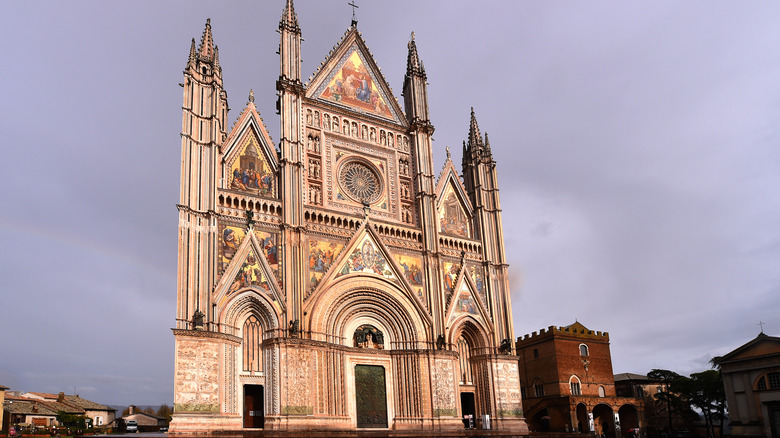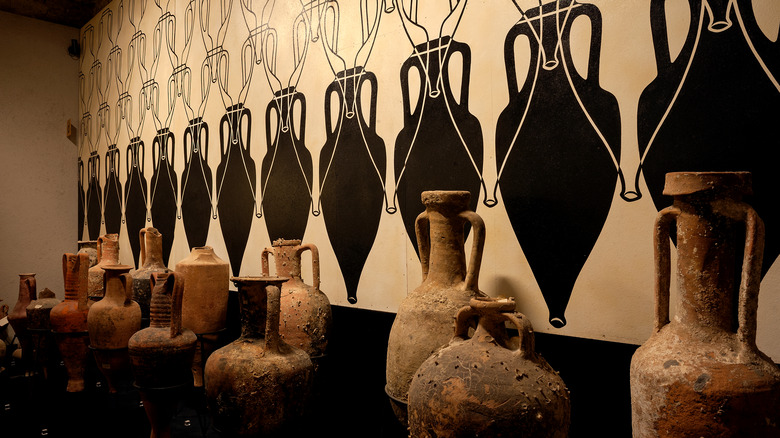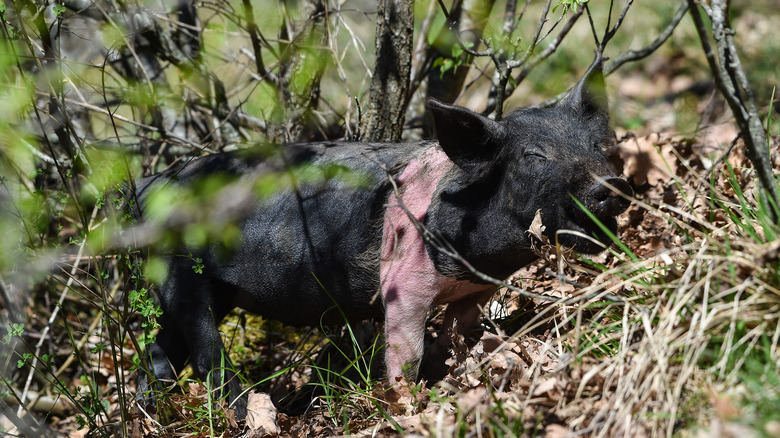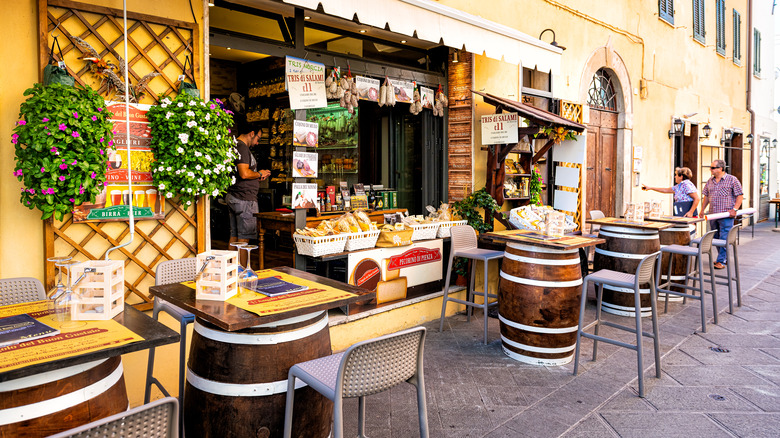The Beginner's Guide To Wines From Umbria
Umbria has a prime situation in central Italy, in the space between two of the country's most popular regions, Lazio and Tuscany. But visitors shouldn't let these famous neighbors steal the spotlight. Umbria is a haven for those looking to make the most of Italian natural beauty, history, cuisine, traditions, and wine. Ensconced entirely within Italy, Umbria has no coastline or international border.
Some people intentionally seek out Umbria, and others stumble upon it. Many visitors discover the Umbrian hill town of Orvieto thanks to a stop on the train line that links Florence and Rome, while others make a pilgrimage to Assisi, the birthplace of the Christian saint Francis. It's also referred to as "Italy's green heart," which is evident by the lush vegetation and swaths of vineyards and olive groves. While the region is as welcoming to travelers as anywhere else in Italy, there is still slightly less crowd pressure than in nearby cities, which makes for an incredible discovery experience. And for wine lovers and foodies, Umbria is a must-know spot that produces over 7 million cases of wine per year, according to Italian Wine Central.
Four consortia set the stage
In Italy, like most of Europe, wine cultivation is subject to a hefty amount of legislation and bureaucracy. While there are various reasons for this, one of the most recognizable to wine consumers is the strict adherence to origin designations. Wines that specifically identify with where they are from must follow the rules and regulations of that spot. This helps buyers understand what they are getting, given that they are familiar with the conditions of the denomination, which is the Italian term similar to the French appellation.
Consortia have formed to represent the interests, communication abilities, and preservation of the wine regions of Italy. They bring stakeholders together to be a voice for the wine, and in Umbria, the consortia are visible and active. Wineries from tiny family establishments to cooperative organizations to large international players may likewise share a role in the consortium. There are four of these in Umbria, each representing distinct wine-growing areas. These are Orvieto, Torgiano, Trasimeno, and Montefalco. Montefalco and Orvieto have the largest number of producing members, and thanks to their well-known hill town reputations and long history of wine production dating back to the Etruscans, they are the most easily found in wine shops in the US. Though perhaps lesser known and exported, Torgiano and Trasimeno are highly worth seeking out.
An underground city of ancient winemaking
Umbria is an interesting region that many critics and fans consider undervalued. As such, it's a spot capable of wines of great quality, but it's less well-known and more approachable in price than neighbors and peers. This is partially because the region makes significantly less wine than nearby Tuscany. However, the viticultural roots here still go back quite far and have influenced Italian wine production since antiquity.
According to Britannica, the current region of Umbria was populated by the ancient Etruscan civilization, which peaked in population around the 6th century BCE. These people and their culture influenced the Romans, who succeeded the Etruscans. Caves and tunnels around Orvieto are attributed to this time period — dwellings and storage spaces with evidence of wine production. Carved out of the volcanic rock under the hilltop village, these caves provided the proper temperature for a long, cool vinification. Because this is an official archeological site, it's no longer in use for wine production, but tours give visitors insight into the long history of the civilization of the Orvieto.
There isn't a textbook Umbrian wine
Because of the region's complexity, there isn't something that you might call a textbook Umbrian wine, But there are key markers and native grapes that give Umbrian wine its identity. In terms of types of white wine, Orvieto DOC leads production with the Trebbiano Toscano, a high-yielding grape variety known locally as Procanico or as Ugni Blanc in France. This grape has a reputation for blending (in France, it's often associated with the production of brandy) and is dry with citrus notes. Because it's not overwhelming, it plays well with various foods.
Toscano is different from Trebbiano Spoletino, a variety that can be highly aromatic and flavorful, which is grown in Umbria near the town of Spoleto. Thanks to a high level of acidity, this grape makes lovely sparkling wine. The other key white wine grape is the medium-bodied and refreshingly acidic Grechetto, which has two distinctions: Grechetto di Orvieto and Grechetto di Todi. Wine connoisseurs can also find international varieties such as chardonnay and sauvignon blanc in Umbria.
The major type of red wine in Umbria is also one of the world's most tannic varieties. Montefalco Sagrantino is among the most age-worthy wines on the planet, thick-skinned and flavor-rich. But this isn't the most cultivated grape — this is, in fact, the familiar favorite Sangiovese, which is an Umbrian mainstay. One of the most interesting red wines in the region is Montefalco Rosso, a blend of Sangiovese, Sagrantino, and at least one other red grape, often merlot.
DOCG champions
There are two DOCG (Denominazione di Origine Controllata e Garantita) growing regions in Umbria — these designations are at the top of the quality pyramid of Italian wine (via Italian Wine Central). There are less than 80 DOCG in all of Italy, and Piedmont is home to the most. In Umbria, the two DOCG are both red wines: Torgiano Rosso Riserva and Sagrantino di Montefalco. Both of these were promoted from DOC status in the 1990s.
Torgiano Rosso Riserva is dry red, with a reputation for elegance and age-worthiness. It's made primarily from Sangiovese and has a concurrent history with the largest producer of the region, family-owned Lungarotti. Sagrantino di Montefalco (also referred to as Montefalco Sagrantino) is one of Umbria's most iconic products next to olive oil and truffles. The dozens of producers who champion this wine are steadfast in recognizing that it's unique. And it is with its supremely tannic structure and savory dark fruit; Sagrantino di Montefalco is probably one of the most obvious wines to identify in a blind tasting. It also can age for years. The evolution of this wine, from sweet and sacramental origins to one of the most age-worthy wines of Italy, is also tied to a backing producer: Marco Caprai from Arnaldo Caprai winery.
A friendly, zero kilometer environment
The vibe in Umbria is friendly and open, and residents will say that this peaceful quality is baked into their history. Landlocked and without international borders, the region isn't known for conflict. To the north is the Apennine Mountains and to the south is the Tiber River Valley — in between are rolling hills and picturesque towns that look exactly like an Italian dream. Situated in all of this are traditional agricultural pursuits: vineyards, olive groves, sunflowers, fishing, corn, and grazing for cheese production. There are even ancient products such as fagiolina del Trasimeno and Senatore Cappelli wheat. This is truly a zero-kilometer environment.
According to Global Forest Watch, about one-third of Umbria is covered in forests. These support world-class hiking and kayaking and are also home to one of Italy's finest delicacies — tartufi or truffles. There is also stunning Lake Trasimeno, the fourth largest in Italy, which supports wildlife and is dotted by charming towns along its coast.
Cultural traditions tell the story of the region
Aside from wine and food, Umbria is tied to other cultural treasures in the realms of music, art, and religion. Though these aren't necessarily wine traditions, they are part of the creative backbone of the region and tell a story about the history of Umbrian culture. Umbria Jazz Festival, which takes place each July in Perugia and surrounds, is one of the world's most celebrated jazz events. Legends such as Miles Davis, Dizzy Gillespie, and Wynton Marsalis have been a part of it. In the winter, Orvieto is the site for Umbria Jazz Winter, another world-class experience for music lovers. During the Renaissance, Umbria fostered some of the most influential artists — such as Pinturicchio, Pietro Vannucci (the Perugino), and Raphael — at the Umbrian School. Galleria Nazionale dell'Umbria is now home to some of the outstanding creations of these masters.
Umbria also draws many pilgrims to religious sites as the homeland of Christian saints, including Francis, Rita da Cascia, Clare, and Benedict of Norcia. Many of these stories of dedication are tied to the natural surroundings of Umbria, such as St. Francis preaching to birds and St. Benedict's connection with the Earth through the cultivation of orchards and fields. One of Italy's most recognizable religious sites, the 14th-century Roman Catholic Orvieto Cathedral, is located here, as well as the Assisi basilica, a UNESCO World Heritage site and the site of the tomb of Saint Francis and frescoes by Giotto and other artists.
Umbria on the bucket list
There are plenty of reasons to visit Umbria, and the wine industry, in particular, draws many travelers from Italy, Europe, and the world. There are hundreds of wineries scattered across the region, many with welcoming tasting rooms and hospitality options. Driving through the countryside, with vineyards and olive groves alternating shades of green, is an opportunity to enjoy the abundance of wine-inspired travel.
Aside from tasting, wine travel in Umbria presents many opportunities to learn. In the center of Torgiano village, one can discover the Wine Museum of Torgiano and the Olive and Oil Museum, both run by the Lungarotti family. For visitors who want to be introduced to hidden gems with first-class service, a company such as Gusto Wine Tours will ensure that excellent sips are interwoven with education and winemaker meetings — and often a meal that pairs Umbrian wine with the local cuisine. There are also exceptional hotels connecting travelers to the wine experience, such as Palazzo Bontadosi in Montefalco and Grand Hotel Italia in Orvieto.
Flavors that defy expectations
Because the scope of wine production in Umbria is so varied, there are plenty of pairing options to choose from. This is a region that might defy expectations if one is mainly accustomed to tomato-based meals and simple Italian pasta dishes that are commonly associated with the cuisine in an international setting. Like many old-world wine regions, Umbrian cuisine and wine are highly local in a "what grows together goes together" way, and wine will grace the table of any meal. Overall, the expression of Umbrian cuisine reflects similarities with Umbrian wine: While not quite a type of natural wine, it is often made by a local family with minimal chemical intervention.
Wild boar, which abundantly roam the countryside, and other game meats are made into ragu spooned onto toothsome pasta. Pork figures strongly in the cuisine of Umbria, particularly the black pig of Norcia, which is used for salami, sausage, or other types of meat for charcuterie boards. The pork tastes terrific with the Sangiovese-based red wines of Umbria. The area is rich in legumes and vegetables — small farms and family gardens are essential features of the landscape. There's also pecorino cheese, young or aged, perfect with Grechetto and Trebbiano Spoletino. And don't forget the fish from Lake Trasimeno, which is lovely with the wine wines and increasing number of crisp rosé from the region. Of course, there's delicious bread and endless types of olive oil, which many wine producers also cultivate and sell. All in all, Umbria features an abundance of Italian dishes you need to try.
Meet the wine producers of Umbria
Today's Umbria, while steeped in history and tradition, is poised for new attention. Long-time producers such as the Todi-based cooperative Tudernum, which represents 350 growers, and 4th-generation winery and farm Scacciadiavoli both have decades of history that continues to shape the region. Meanwhile, there are also wineries coming forward with a new outlook on the classics, such as all-organic Terre Margaritelli, which has cultivated a unique oak aging program that utilizes specifically sourced barrels for particular wines.
There are wine establishments that also focus on hospitality, such as Decugnano Dei Barbi, which has a luxury villa that vacationing families can enjoy in search of the dolce vita. Azienda Agricola Tabarrini, led by the president of the Montefalco consortium Giampaolo Tabarrini, has one of the most technologically advanced cellars (and gorgeous hospitality area) to produce iconic Montefalco Sagrantino. And the natural and organic wine ethos is met with purity at spots like Antica Azienda Agricola Paolo Bea, where an efficiency-designed winery and low-intervention wine production are viewed as standard bearers for ecological responsibility. These are only some of the names that contribute to the excitement and quality of Umbria, which is truly at the heart of Italy.
